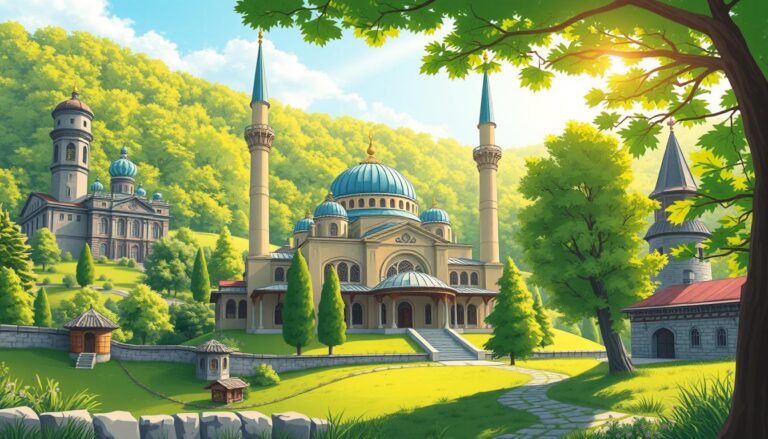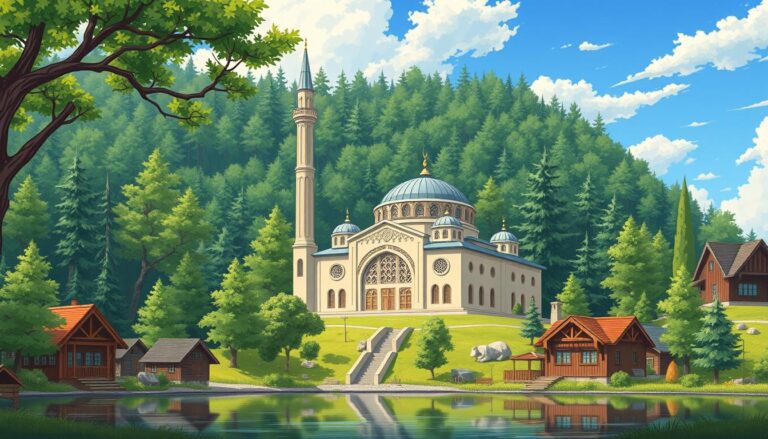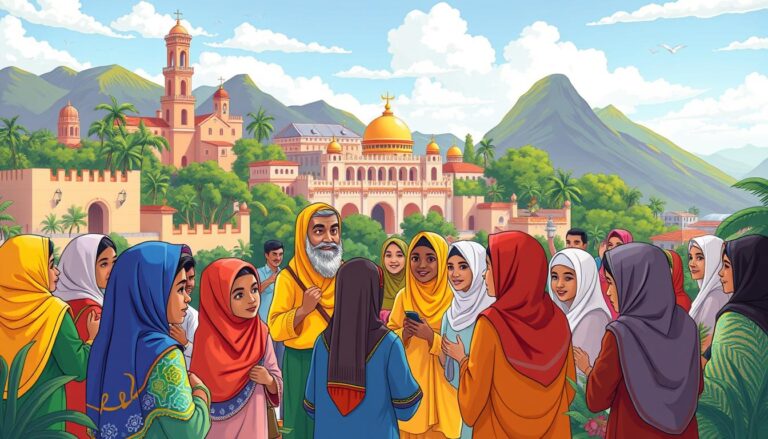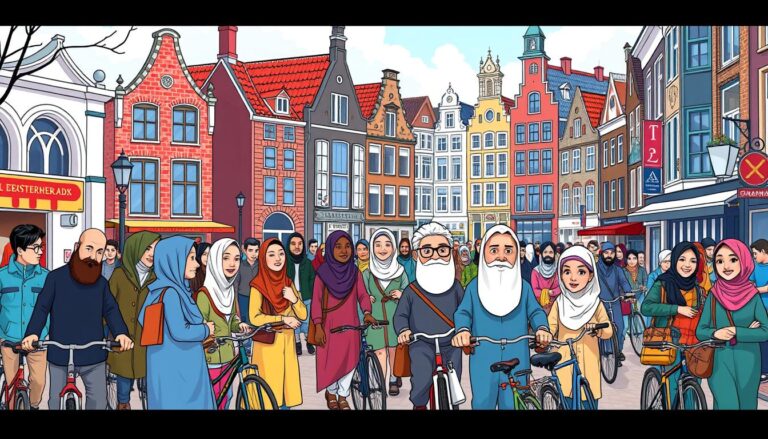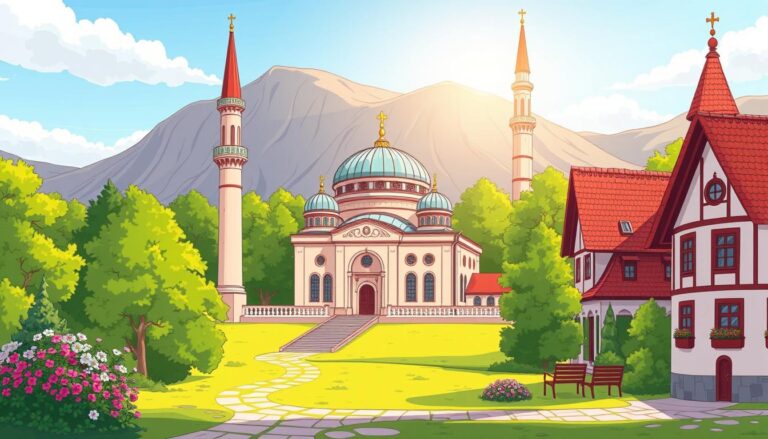Islam in Mexico
While Mexico is predominantly a Christian-majority country, the presence of Islam in the nation is undeniable. According to the National Institute of Statistics and Geography (INEGI) census in 2010, there were a mere 2,500 individuals who identified as Muslim, representing a minuscule fraction of the country’s total population of 126 million. However, the Pew Research Center’s projections suggest a gradual increase, estimating the Muslim population to reach 126,000 by 2030.
Key Takeaways
- Mexico’s Muslim population is small, accounting for less than 0.01% of the total population.
- The Muslim population in Mexico has grown from 60,000 in 1980 to an estimated 111,000 in 2010, and is projected to reach 126,000 by 2030.
- Islam has been present in Mexico since the mid-1950s, primarily due to Spanish and Arab settlement, as well as conversion among indigenous Mayan and Tzotzil communities.
- Mexico has several mosques and Islamic organizations, such as the Centro Cultural Islámico de México (CCIM) and the Centro Salafi de México, catering to the Muslim community.
- The Muslim community in Mexico is diverse, with both foreign nationals and Mexican converts, following various Islamic denominations, including Sunni and Ahmadi.
Demographics of Muslims in Mexico
The Muslim community in Mexico, though numerically small, represents a diverse and growing presence in the predominantly Catholic country. According to the latest estimates, the Muslim population in Mexico is estimated to be over 120,000 individuals, making up less than 1 percent of the nation’s 120 million inhabitants.
Population Statistics and Diversity
The Muslim demographic in Mexico is characterized by a significant conversion trend, particularly among the indigenous Mayan population in the state of Chiapas. Since the late 1980s, a growing number of Mayans have embraced Islam, with the community now comprising a disproportionate number of the country’s Muslim adherents.
Beyond the indigenous Mexican Muslims, the overall Muslim population in the country is diverse, with origins spanning not only Mexico but also immigrants and descendants from other Latin American nations. This diversity is reflected in the more than forty mosques scattered across Mexico, with four located in the capital city of Mexico City.
The distribution of mosques throughout the country, with only seven out of the thirty-two states lacking a place of Islamic worship, highlights the widespread presence of the Muslim community in Mexico.
“The Muslim community in Mexico is estimated to be over 120,000 individuals, highlighting the presence of Islam in the country.”
Historical Presence of Islam in Mexico
The history of Islam in Mexico dates back to the mid-1950s, when a significant influx of Spanish and Arab settlers brought the religion to the country. One key event was the arrival of the Spanish Murabitun community, the Comunidad Islámica en España, based in Granada, Spain, and one of its missionaries, Muhammad Nafia (formerly Aureliano Pérez), now the emir of the Comunidad Islámica en México. They established a commune in the city of San Cristóbal in the state of Chiapas shortly after the Zapatista uprising.
The Islamic presence in Mexico has steadily grown over the decades. By 1994, more than 700 indigenous Mayans and Tzotzils had converted to Islam. Census data from the last few decades reflects this trend, with the Muslim population in Mexico nearly doubling from 3,760 in 2010 to 7,982 in the most recent count.
Historically, the Muslim community in Mexico has been diverse, with Arab diasporas making up only about 1% of the population during the late nineteenth and mid-twentieth centuries. However, a “re-Islamization” occurred in the late twentieth century, as Arab, Turkish, and Pakistani migrants arrived, contributing to the growth of local Muslim groups and the establishment of mosques and prayer halls.
The origins of Islam in Mexico can be traced back to the arrival of Muslim settlers in the late fifteenth century, as part of the religious and cultural landscapes of the Americas. Today, various Islamic organizations, such as the Muslim Center de Mexico, are actively working to introduce and promote Islam to the Mexican public, which has a population of over 100 million.
“Islam has been present in the Americas since the late fifteenth century, forming part of the religious and cultural landscapes.”
Indigenous Mexican Muslims
Mexico, a country rich in cultural diversity, is home to a growing number of indigenous Muslims, a fascinating facet of the nation’s religious landscape. These indigenous Muslims in Mexico have their roots firmly planted in the country’s Mayan and Tzotzil heritage, blending their traditional practices with the teachings of Islam.
Conversion to Islam
The conversion to Islam in Mexico can be traced back to the late 1980s, when the Spanish Murabitun community, based in Granada, Spain, established a presence in the state of Chiapas. Through their outreach efforts, they were able to convert many indigenous Mayans and Tzotzils to the faith. By 1994, more than 700 Tzotzils had embraced Mayan Muslims and Tzotzil Muslims in Mexico.
However, the journey of these indigenous Mexican Muslims has not been without its challenges. Many have since departed from the Murabitun and formed ties with the Centro Cultural Islámico de México (CCIM), aligning themselves with the orthodox Sunni school of Islam. This transition has allowed them to establish the Al-Kausar Mosque in San Cristobal de las Casas, a symbol of their commitment to their newfound faith.
Despite these changes, the vast majority of Native Mexicans today remain non-Muslims, highlighting the continued diversity of religious beliefs within the country’s indigenous communities.
Organizations and Mosques
The Islamic organizations in Mexico have a strong focus on grassroots missionary activities, which are most effective at the community level. The Centro Cultural Islámico de México (CCIM), a Sunni organization headed by Omar Weston, a British-born Mexican convert to Islam, has been active in several major cities across northern and central Mexico. Additionally, there is a small Salafi organization, the Centro Salafi de México, led by Muhammad Abdullah Ruiz, and an educational center managed mainly by Muslims from Egypt and the Middle East, the “Centro Educativo de la Comunidad Musulmana en México”.
Mexico City is home to a branch of the Nur Ashki Jerrahi Sufi Order, which is often at odds with the traditionalist Muslim community and is headed by two women, Shaykha Fatima Fariha and Shaykha Amina Teslima.
Prominent Islamic Organizations
- The Centro Cultural Islámico de México (CCIM), a Sunni organization, has been actively translating Islamic publications into Spanish and establishing new mosques in cities close to the capital.
- The Centro Salafi de México, a small Salafi organization, is led by Muhammad Abdullah Ruiz.
- The “Centro Educativo de la Comunidad Musulmana en México” is an educational center managed mainly by Muslims from Egypt and the Middle East.
- The Nur Ashki Jerrahi Sufi Order branch in Mexico City is headed by two women, Shaykha Fatima Fariha and Shaykha Amina Teslima.
“The ultimate goal of CCIM is to establish full-time mosques in every major Mexican city.”
Islam in Mexico
Despite being a predominantly Christian country, Mexico has a small but thriving Muslim community that has found a place in the nation’s diverse religious landscape. According to the 2020 Mexican government census, only 0.2% of the population identifies with religions other than Catholicism and Protestantism/Evangelical Christianity, which include Judaism, Jehovah’s Witnesses, The Church of Jesus Christ of Latter-day Saints, and Islam.
The Muslim community in Mexico has been embraced by the broader society, with the country generally respecting the religious practices and traditions of its Muslim population. In recent years, a significant influx of local Mexicans have converted to Islam, further enriching the diversity of the Muslim community.
“The Muallimin Course in Mexico had three students enrolled: José Vicente Briones León Sahib (48 years old), Francisco Iván Padrón Herrera Sahib (42 years old), and Luis Fernando Gómez Gómez Sahib (22 years old). The course covers subjects like the Holy Quran, hadith, literature of the Promised Messiahas, and comparative religions.”
The role of Islam in Mexican society is multifaceted, with the Muslim community in Mexico playing an important part in the country’s cultural and religious fabric. The role of Islam in Mexico continues to evolve, as more Mexicans embrace the faith and contribute to the growing diversity of the nation.
Legal Framework and Religious Freedom
Mexico’s constitution provides all individuals the right to religious freedom, including the freedom to engage in religious ceremonies and acts of worship. The constitution also declares Mexico a secular state, prohibiting Congress from establishing or prohibiting any religion.
While religious groups in Mexico are not required to register with the General Directorate for Religious Affairs (DGAR) to operate, registration is necessary for various legal matters such as negotiating contracts, purchasing or renting land, applying for official building permits, receiving tax exemptions, or holding religious meetings outside of customary places of worship. In 2023, the DGAR registered 196 new religious associations, up from 149 the previous year.
The legal status of Islam in Mexico and the religious freedom afforded to Muslims are protected under the country’s constitutional framework. Mexico’s secular state and commitment to religious freedom ensure that Muslims can practice their faith without hindrance, subject to the same requirements and provisions as other religious groups.
While the overall religious landscape in Mexico is predominantly Roman Catholic, with approximately 78% of the population identifying as such, the country also has a diverse religious makeup. This includes Protestant and evangelical Christian communities, as well as smaller populations of Muslims, Jews, Buddhists, Hindus, and followers of other faiths.
The constitutional protections for Muslims in Mexico, combined with the country’s commitment to religious diversity and freedom, create an environment where the Islamic faith can be freely practiced and its adherents can participate in the social, cultural, and political life of the nation.
Challenges and Discrimination
While the Mexican government generally respects religious freedom, the Muslim community in Mexico has faced its share of challenges and discrimination. Despite the country’s religious diversity, incidents of intolerance and expulsions targeting religious minorities, including Muslims, have occurred in certain regions.
Incidents and Expulsions
In May 2020, an indigenous community in the state of Chiapas expelled six evangelical Protestant families, highlighting the ongoing tensions around religious identity and traditional beliefs. Similarly, in October 2020, local community leaders in San Cristobal de las Casas drove out 33 evangelical Protestants for not adhering to the community’s traditional faith.
These incidents underscore the challenges facing Muslims in Mexico, as well as the discrimination against Muslims in Mexico and other religious minorities in certain parts of the country. The incidents of religious intolerance experienced by the Muslim community and other faiths serve as a reminder of the need for continued efforts to promote religious tolerance and understanding.
“These incidents highlight the ongoing challenges faced by religious minorities in certain parts of Mexico.”
Despite the overall respect for religious freedom, the experiences of some Muslim communities in Mexico suggest that more needs to be done to ensure equal treatment and protection for all faiths. Addressing these challenges facing Muslims in Mexico and promoting diversity and inclusion will be crucial for maintaining the country’s rich religious and cultural tapestry.
Moorish Architecture in Mexico
The influence of Moorish and Islamic architecture can be clearly seen in several structures across Mexico, particularly in the state of Chiapas. One prime example is the “La Corona” or “La Pila” fountain in Chiapa de Corzo, which was built in the 16th century by Spanish Dominican friars and exhibits a strong Mudejar influence – a style that blends Islamic and Christian architectural elements.
Furthermore, the Morisco Kiosk in the Colonia Santa María la Ribera neighborhood of Mexico City was constructed in the neo-Mudejar style, which was prevalent in 19th-century Spain and showcased the lasting Moorish influence in Mexican architecture.
“The Moorish influence in Mexican architecture is a fascinating legacy that continues to captivate visitors and scholars alike.”
This Islamic-inspired architecture in Mexico can be attributed to the long-standing Spanish colonial rule, which lasted over 300 years and saw the blending of Spanish and indigenous design elements. The Mudejar style, in particular, has left an indelible mark on Mexico’s architectural landscape, combining the best of both Moorish and Spanish traditions.
Beyond the architectural realm, the Moorish influence in Mexican architecture has also extended to the country’s cuisine, with spices like coriander, cumin, cinnamon, and clove finding their way into traditional Mexican dishes. This cross-cultural exchange is a testament to the enduring legacy of the Moors in shaping Mexico’s rich cultural heritage.
Notable Muslims in Mexico
While Islam may not be the most prominent religion in Mexico, the country is home to a diverse community of influential Muslim figures who have made remarkable contributions to various fields. From artists and intellectuals to community leaders, these prominent Muslims in Mexico have left an indelible mark on the cultural and social fabric of the nation.
One notable Muslim living in Mexico is Fitra Ismu Kusumo, an Indonesian artist based in the country. Kusumo’s work often explores themes of Islamic spirituality and the interplay between Islamic and Mexican cultural elements, offering a unique perspective on the intersections of faith and identity.
Another prominent Muslim in Mexico is Sheikh Isa García, who embraced Islam in 1989 in Buenos Aires. García specialized in da’wah (the act of inviting people to the Islamic faith) and has translated the Quran into both Castilian Spanish and Latin American Spanish, making the holy text more accessible to Hispanic and Latino Muslim communities.
The Mexican Muslim community also boasts influential figures like Br. Ibrahim González, who co-founded Alianza Islámica, one of the first Latino masjid/Islamic centers in the United States, in the late 1980s. González’s efforts have played a crucial role in fostering a sense of community and identity among Hispanic and Latino American Muslims.
These are just a few examples of the remarkable Muslim artists, intellectuals, and community leaders who have left an indelible mark on Mexico’s cultural and social landscape. Their contributions not only enrich the vibrant tapestry of the country’s diverse religious landscape but also serve as inspirations for future generations of prominent Muslims in Mexico.
Conclusion
While Islam represents a small minority in the predominantly Christian nation of Mexico, the Muslim community in the country has a growing presence and continues to make its mark on Mexican society. From the historical presence of Islam in Chiapas to the establishment of mosques and Islamic organizations in various parts of the country, the Muslim population in Mexico is diverse and vibrant.
Despite occasional challenges and incidents of discrimination, the Mexican government generally respects the religious freedom of its citizens, allowing Muslims to freely practice their faith and contribute to the cultural fabric of the nation. Estimates indicate a current Muslim population in Chiapas ranging from 300 to 500 individuals, largely due to the efforts of a Spanish Sufi Muslim group engaged in missionizing work.
The future of Islam in Mexico appears promising, as the Mayan Muslim community continues to expand, running businesses and spreading the teachings of Mohammed within their families and communities. As the country navigates the complexities of religious diversity, the Muslim population in Mexico remains an integral part of the nation’s rich cultural tapestry.
Source Links
- Islam in Mexico
- Mexico – United States Department of State
- ‘From haram to halal’: How a bar became a shelter for Muslim migrants in Mexico
- Mexico, Muslims, and Cinco De Mayo – Islamic Circle of North America (ICNA)
- The Mexican Muslims living in the Maya heartland
- Table: Muslim Population by Country
- Islam in Mexico: Diversity, Accommodations, and Perspectives on Approach – International Journal of Latin American Religions
- Islam in Mexico
- Islam in Mexico: Diversity, Accommodations, and Perspectives on Approach
- The link to a hidden Islamic heritage
- This Small Indigenous Village in Chiapas, Mexico Is Converting to Islam
- List of mosques in Mexico
- Mexico Discovers Islam
- Muslim Mexicans vie to spread Islam: The first muallim course in Mexico Jamaat
- Mexico – United States Department of State
- Mexico – United States Department of State
- Mexico – United States Department of State
- Islamic Radicalism in Mexico: The Threat from South of the Border
- Mexico and Morocco: A Shared Architectural Heritage
- Mexico’s Hidden Arabic Heritage
- Hispanic and Latino American Muslims
- Notable Contemporary Latino Muslims You Should Know – Wisconsin Muslim Journal
- Islam in Mexico
- Islam in Chiapas: An Overview and Critical Engagement with the Sources – Maydan
- Praying to Allah in Mexico: Islam Is Gaining a Foothold in Chiapas


